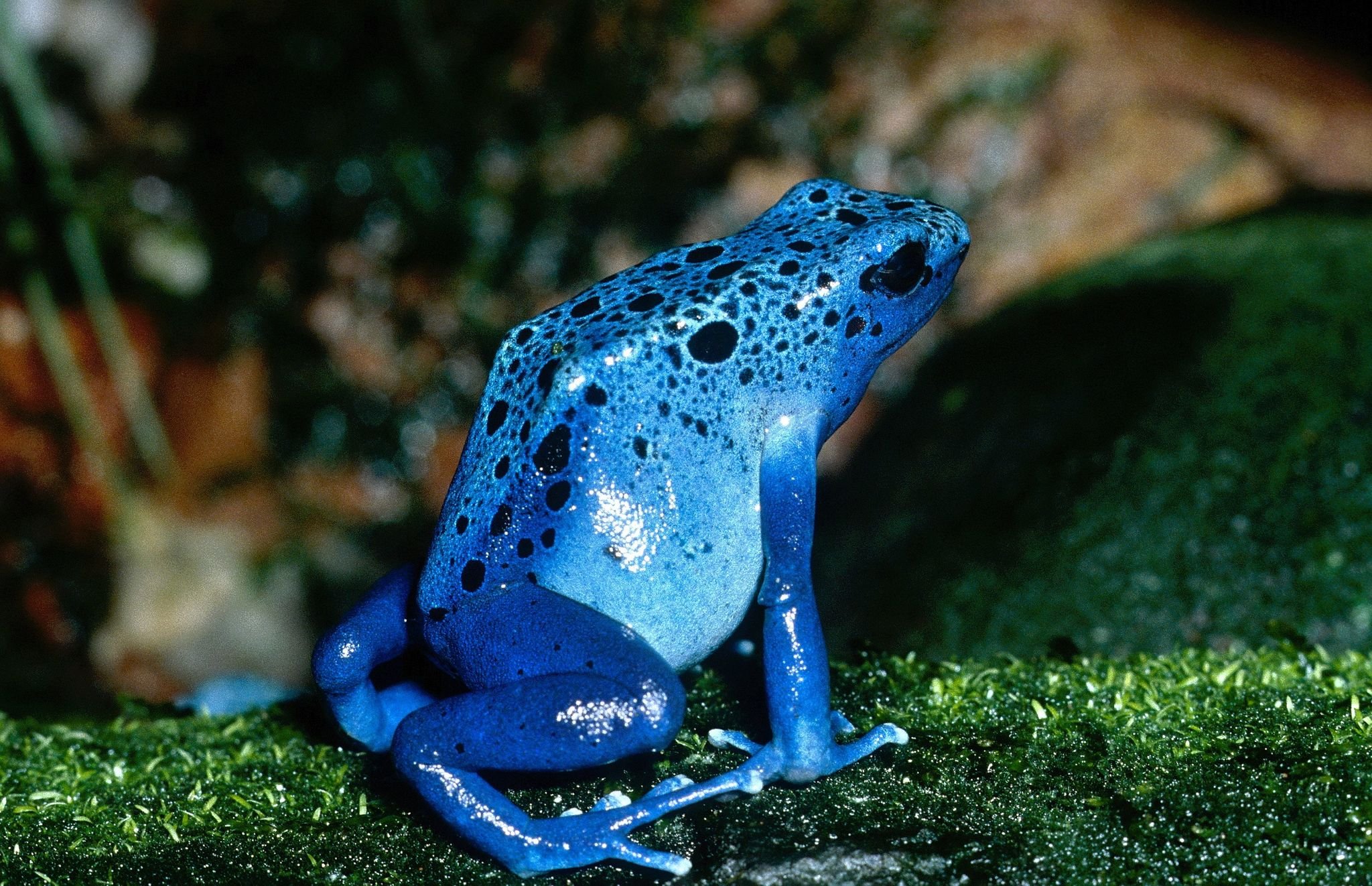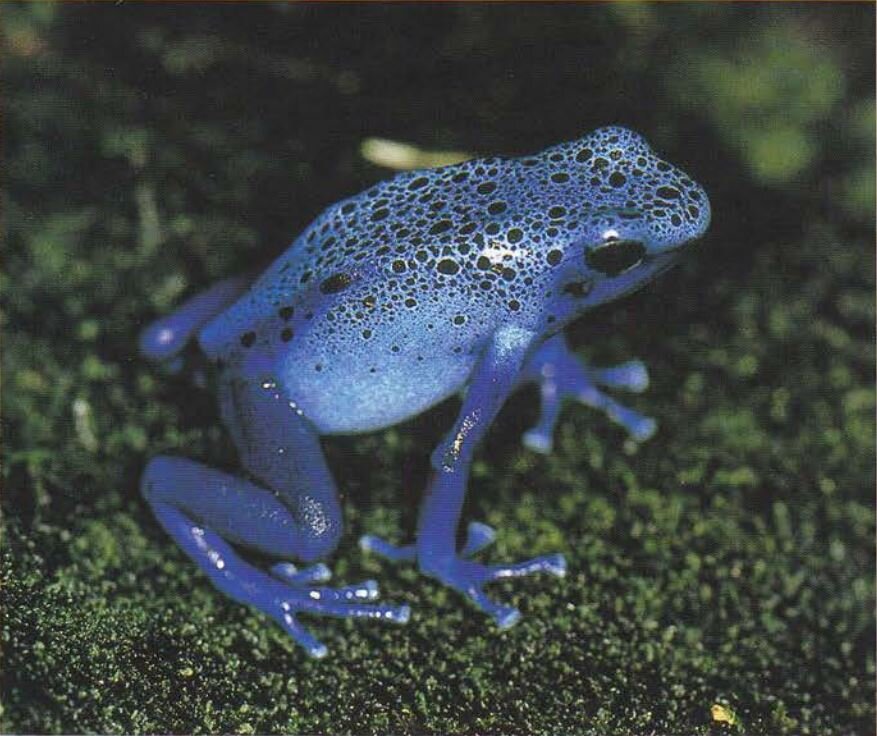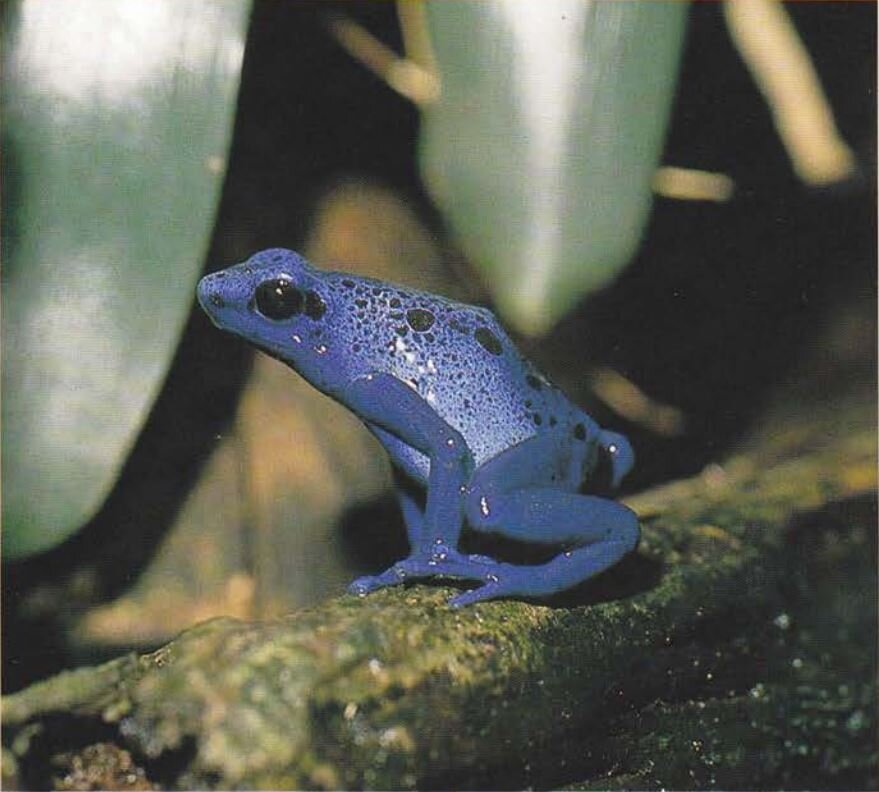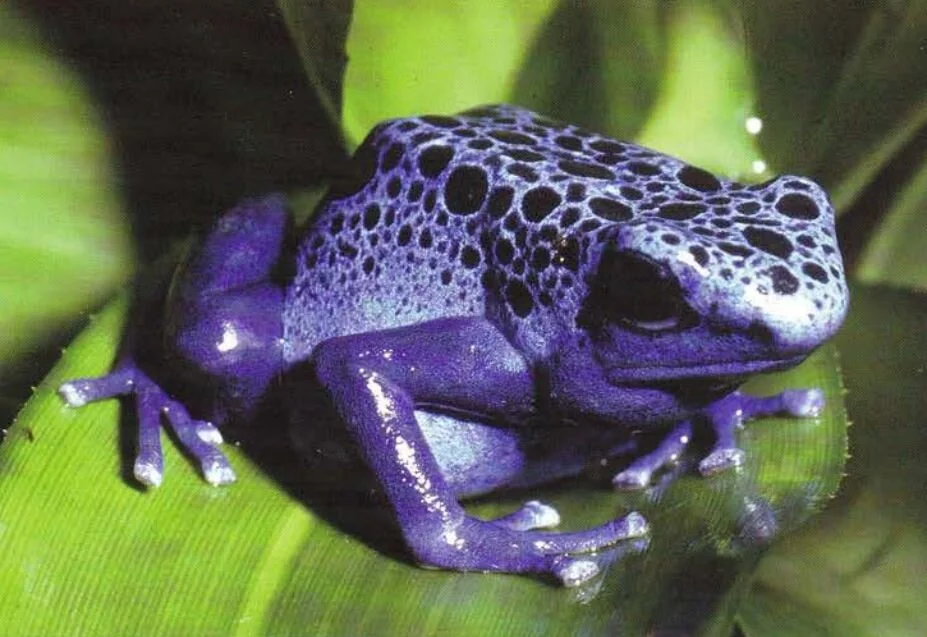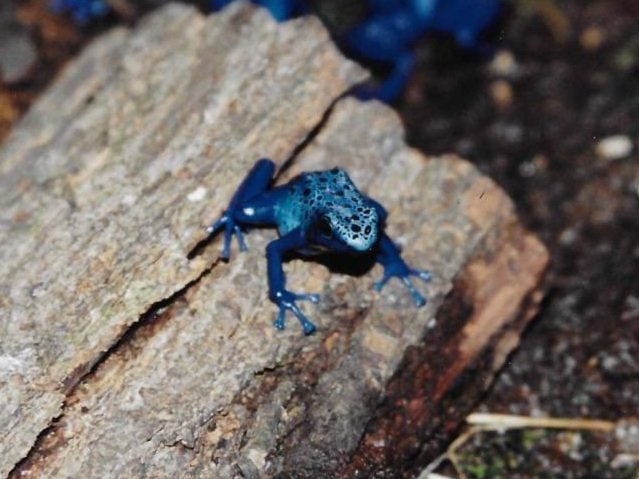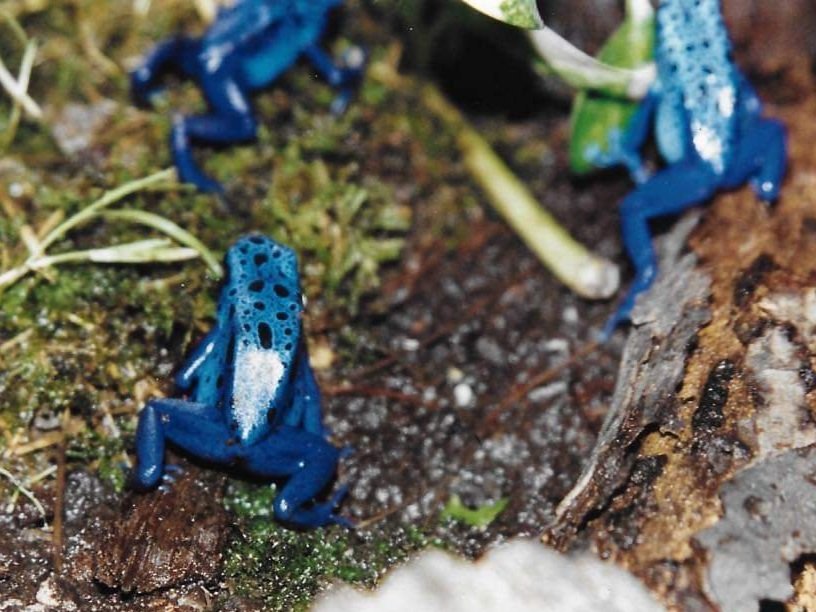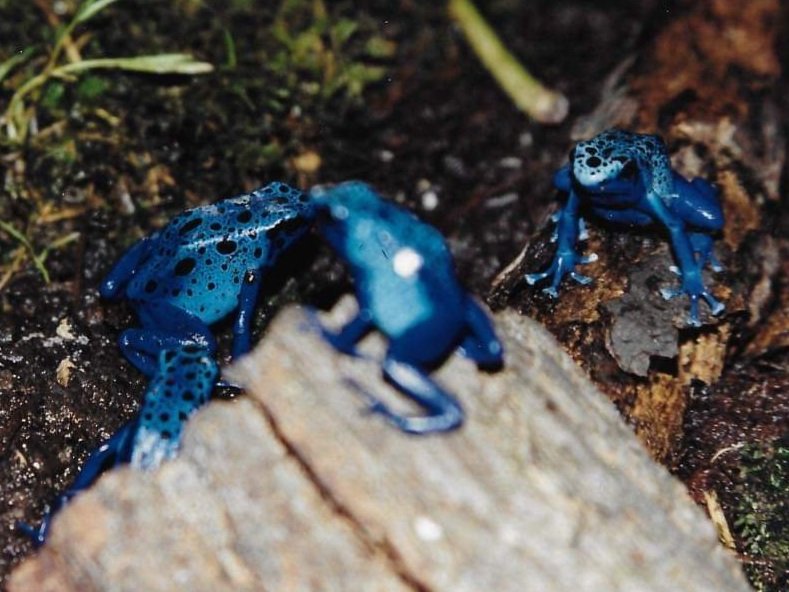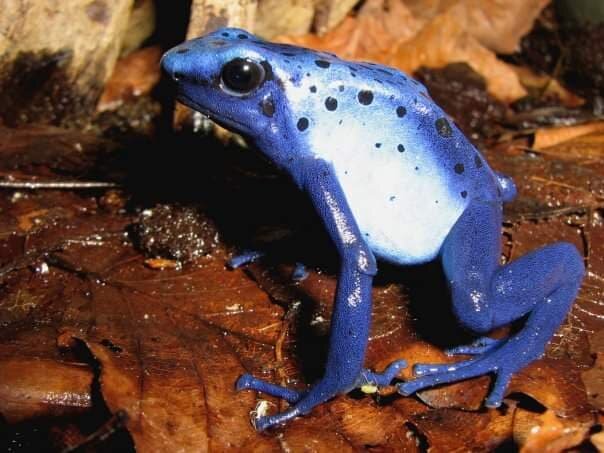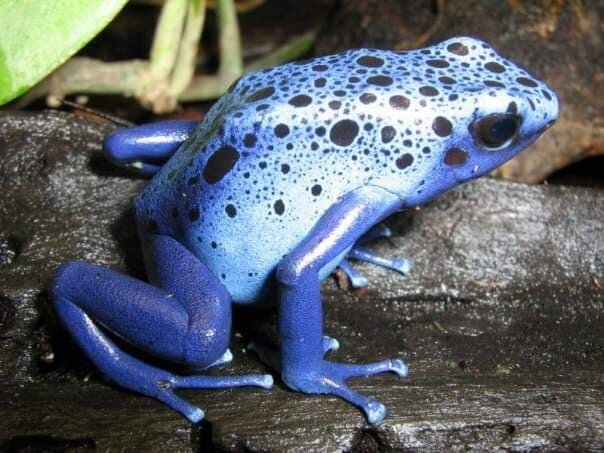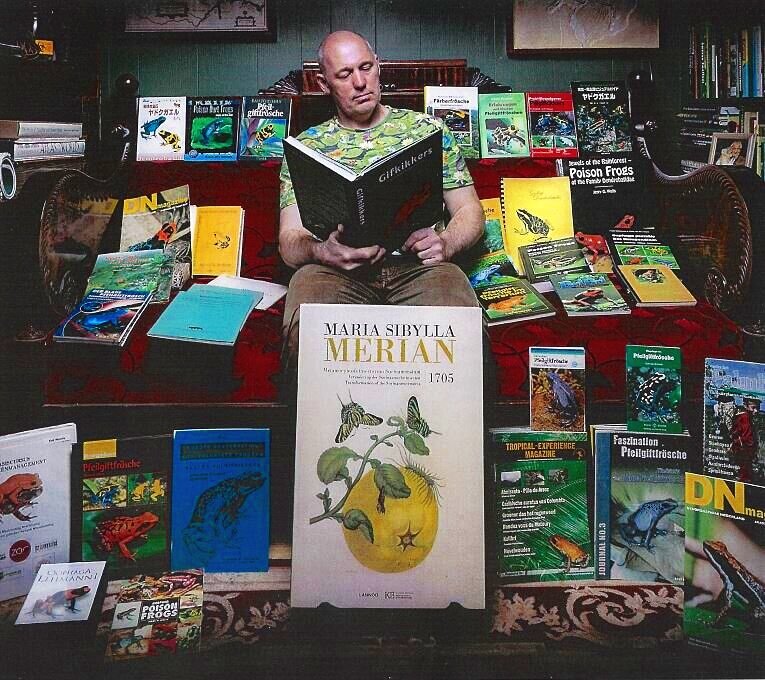Azureus - History of the Poison Dart Frog Icon
One of the very first wild Azureus ever kept in captivity.
1981, Switzerland. Photo credits to Rolf Bechter.
The blue poison dart frog, Dendrobates tinctorius ‘Azureus’ (formerly Dendrobates azureus), has a rich history among the dart frogs found in private collections. Beginning as the “holy grail” of dart frogs and fetching high dollar prices, Azureus can now affordably be found online or at locale pet stores with relative ease. But how many Dendrobatid aficionados really know all about the history of this adored blue frog?
Many layman assume that Azureus can only be traced back to one or two limited imports, but that is not the case. This is a timeline that attempts to document any point in time where Azureus either entered captivity or circulated amongst hobbyists from country to country. This is an accumulation of hours upon hours of research scouring archival texts on the internet and countless communications with fellow hobbyists that experienced these events firsthand. It is a great privilege to be able to present the history of this beautiful dart frog and eliminate the hearsay.
Hopefully the true Azureus lovers will find this article fascinating from a historical perspective. The long time froggers may find many of the old names mentioned here to be nostalgic. Rather than being served as a story, this is a timeline that is intended to be more of an index and will be updated as more information comes to light. Many fascinating historical photos associated with the history of Azureus in captivity are preserved here for all to enjoy. Seeing true wild specimens and their F1 progeny may also serve as a model for comparisons to be made to the specimens we currently keep in captivity.
1970
After his discovery in 1968, Dr. Marinus Hoogmoed revisits the Sipaliwini savanna in 1970. In the morning of February 7, 1970, he collects 10 specimens, 6 males and 4 females, and brings them back alive to Holland. Half of these specimens were directly given to Wouter N. Polder on February 20, 1970. Dr. Hoogmoed maintained the other 5 specimens in a terrarium for about a year. After this time, they were also given to W.N. Polder in February 1971.
One of Dr. Hoogmoed’s terrarium animals
According to Dr. Hoogmoed, 8 of the original 10 animals were still alive in May 1973. Of the original 10 specimens, 9 were adults at capture and 1 may have been younger. One of the original males only had one eye, the other eye socket was empty. This specimen had trouble feeding and lost weight rapidly until he passed away half a year later. Another male showed strange behaviour on April 10, 1972, moving in circles on the ground, with one forelimb stretched out. He passed away soon after on May 2, 1972.
Hoogmoed notes that the imported specimens were not shy and were not frightened by people getting close to their enclosure. However, the F1 specimens were very shy and fled when someone came close.
From November 1, 1971 to November 1, 1972, four of the imported females laid a total of 156 eggs, monthly clutches varying from 4 to 24 total eggs. Several females were kept in the same terrarium. Unfortunately, fungus is believed to have caused 2/3 of the eggs to die prematurely.
In the fall of 1972, 10 tadpoles metamorphosed, but their growth was stunted and died tiny and frail. In his December 1974 paper, Polder explains that he had 25 F1 specimens that looked fine, but the productivity of the parents was progressively diminishing.
Between 1973 and 1974, a disease destroyed all of Polder’s original stock.
The animal on the left is a collected specimen. The animal on the right was photographed in the wild though it may have been collected as well.
Photos courtesy of Dr. Marinus Hoogmoed
1981
Ton de Liefde (Netherlands) and Matthias Knelier (Germany) imports a group of Azureus.
Ledia Dvořák imports 8 pairs of Azureus from the Sipaliwini savanna to Switzerland. Martin Haberkern acquired 4 of the original pairs and the rest were given to two fellow hobbyists.
Martin Haberkern bred the animals and their descendents for many years. While maintaining a studbook, Martin recorded hundreds of offspring from this import. Their progeny made their way into multiple zoos and private collections.
The imported adults are pictured below.
Photo credits to Rolf Bechter
1982
Matthias Knelier successfully reproduces Azureus and distributes the offspring across Germany.
1983
One CITES document reported a “minimal estimate” of at least 40 offspring of Dendrobates azureus produced in the Netherlands in 1983. There was only one breeder of Azureus in the Netherlands at the time and that was W. N. Polder. Ton de Liefde acquired several animals from W. N. Polder and would later successfully reproduce them.
In the United States, an exotic animal dealer imports between 20 and 25 Azureus on November 25th, 1983. The National Aquarium in Baltimore purchased a majority of these animals, possibly all of them. This is the first documented moment of Azureus kept in captivity in the United States.
1984
Erik Wevers obtains his first animals from Ton de Liefde. After De Liefde lost all of his animals to a disease in 1985, Erik became one of only a few hobbyists in the world with Azureus in their private collections. Erik Wevers became the only breeder of Azureus in the Netherlands and a majority of Azureus in the Netherlands can be traced back to Erik Wevers.
Erik Wevers’ founding stock. Photos courtesy of Erik Wevers.
1985
For the sixth meeting of the conference of the parties to CITES, Ottawa, Canada, 12-24 July 1987, Dendrobates spp. were proposed for inclusion in Appendix II of CITES. According to the document on file for this meeting, the Suriname Forest Service reported that 2 specimens of Dendrobates azureus were exported to the United States in 1985. It is unknown what became of these animals or where they ended up.
1988
An illegal import of 3 animals is confiscated in the Netherlands. These animals are transferred to the Rotterdam Zoo.
Interestingly, in the May 1988 edition of the ISSD Newsletter, Dale Bertram offered pre-orders for wild-caught adults from an importer. The minimum quota may not have been meet because no Azureus are believed to have been imported into the United States this year.
The 3 animals confiscated in the Netherlands. Photos courtesy of Erik Wevers.
1989
On June 13, 1989, Erik Wevers legally imports 10 Azureus into the US. These animals were F2 offspring from unrelated F1 animals. Included in the import were 8 juveniles that went to individual hobbyists and an unrelated adult pair that went to Dale Bertram, founder of the ISSD newsletter that ran from 1988 to 1991. It is unknown what became of the 8 juveniles, but the pair that Bertram obtained became the earliest foundation stock for Azureus in the US hobby. Dale Bertram earned the title of the first private collector to successfully reproduce Dendrobates azureus in the United States that same year.
The first breeding pair in the collection of a private US hobbyist. Photo credits to Dale Bertram and Erik Wevers.
1991
Chuck Nishihara is one of the first private collectors to obtain captive-bred Azureus from the National Aquarium in Baltimore. In 1991, Chuck first starts distributing offspring from his NAIB bloodline to other private collectors in the US. Private collectors would later interbreed this stock with the Wevers stock.
Between 1990 and 1991, Erik Wevers brings 30 more young animals to the United States for Dale Bertram. Under the trade name “The Blue Frog Emporium”, Dale Bertram first publicly advertises captive-bred Azureus for sale to US hobbyists. Some of the animals that Dale sold were directly from Erik Wevers that he brought over from the Netherlands and some were offspring from Dale’s personal pair. The National Aquarium in Baltimore would later obtain some offspring from Dale Bertram’s lineage to diversify the genetics of the Azureus breeding program.
F2 offspring from Dale Bertram in September 1997. Photos courtesy of Jenny Hackforth-Jones.
1992
By 1987, when Jack Cover began working for the National Aquarium in Baltimore, the original group of Azureus they acquired from an importer in 1983 had dwindled down to just 1 male and 3 females. It is from these 4 animals that they finally began to breed and start building up a population. This also lead to the need to acquire more diverse genetics since the gene pool had effectively bottlenecked by this point.
On September 14, 1992, Jack Cover traveled to Holland in the Netherlands. Along with him, he brought 9 captive-bred Azureus from the Baltimore Aquarium’s bloodlines. They were hatched between September 1991 and June 1992. The origins of these animals are from the animals that the Aquarium acquired in 1983, being produced by an F1 male from one pair and an unrelated wild female from the original import. These animals were traded with the Dutch Dendrobatid Society for as many different bloodlines as possible. All or a majority of these animals came from Erik Wevers’ stock. The animals that were acquired in Holland were brought back to the Baltimore Aquarium to add to the gene pool of the Aquarium’s older stock.
1993
In the Netherlands, the Rotterdam Zoo exchanges the 3 specimens that were confiscated in 1988 for some captive-bred animals with Erik Wevers in order to expand the genetics of Erik’s breeding program. These specimens successfully reproduced for the first time after obtained by Erik.
In the United States, Jack Wattley imports between 40 and 50 animals. These animals were not hidden in a shipment of fish, rather they were imported as “Dendrobates tinctorius” while at the time they were still recognized as “Dendrobates azureus”. Jack also did not collect these animals himself, contrary to popular belief. The Azureus were obtained through a trade with the exporter in Suriname. At the time, Jack received a lot of criticisms in the zoological community because he traded the exporter some Discus and the fear was that these could accidentally be introduced to the wild and become naturalized in a country where they were not native. Jack kept 3 or 4 pairs of these Azureus for himself and sold the rest to other dart frog hobbyists. Jack kept all of the individuals with the least black markings, while the rest of the import that he sold looked like stereotypical Azureus. Mark Pulawski worked directly with Jack Wattley during this time and obtained 9 of the original imported animals. Together, Jack Wattley and Mark Pulawski were the two major producers of captive-bred Azureus at the time in the US and a majority of Azureus in the US hobby can be traced back to these two breeders. Mark later sold one of his wild-collected pairs to Patrick Nabors of Saurian Enterprises.
Some of the original specimens imported by Jack Wattley. Photos courtesy of Mark Pulawski.
1994
In the American Dendrobatid Group Newsletter issue no. 17 (September-October 1994), Jack Wattley advertises the first captive-bred offspring from his 1993 wild catch. These are F1 animals and it can clearly be seen that they are already showing the phenotype for which the Wattley line has become known for. Jack never reproduced these Azureus for more than a generation or two and in fact did not intentionally line breed to obtain this phenotype.
Sometime around this time period, Glades Herpetological in Florida, USA exports Azureus to Canada. Hilde Wagner was the recipient of these animals. It is believed that this exported group was offspring from the Wattley import.
F1 Azureus produced by Jack Wattley. Photo credits to Greg Sihler.
1995
Reptile Specialties, owned by John Uhern, offers Azureus for sale in his mailing list. These animals were captive-bred imports from Ruud Schouten of Dutch Rana in Holland. John would continue to offer Azureus until 2003. The lineage of these animals was likely related to the stock that Jack Cover brought to Holland from NAIB in 1992 and the stock from Erik Wevers.
Sometime between 1993 and 1995, Ian Hiler from the Aquarium of the Americas imported a group of Azureus from the Stuttgart Zoo in Germany through a zoo exchange. Ian Hiler would later distribute captive-bred offspring to private hobbyists in the United States.
1997
Due to rumors that fires destroyed the type locality, the National Aquarium in Baltimore planned an expedition to investigate the habitat in 1996. After visiting the Sipaliwini Savanna and discovering that the rumors were not true, a second expedition commenced in August 1997. The team lead by Jack Cover, Curator of Rainforest Exhibits for the National Aquarium in Baltimore, and accompanied by Robin Saunde1s, Curator of Amphibians at the Cincinnati Zoo, Anthony Wiesniski, Curator of Reptiles at the Baltimore Zoo, and Ron Gagliardo, Curator of The Fuqua Conservatory at Atlanta Botanical Gardens, collected 20 specimens (10 males and 10 females) for a captive breeding program.
One of the animals spotted on the expedition (not collected). Photo courtesy of Ron Gagliardo.
Stipulations of the agreement with the Suriname Forestry Service required that the animals collected and any of their offspring remain property of the Suriname government. The Baltimore Aquarium kept all of the founder stock and has only distributed offspring to other zoos and aquariums. Offspring were never sold directly to private collectors. Any institutions that received offspring from the collected specimens also received a copy of the CITES export permit that explicitly stated all of the collected animals and their offspring were property of Suriname.
Contrary to some rumors, the older stock that the National Aquarium in Baltimore maintained since 1983 was never terminated. The newly acquired stock from 1997 was interbreed with the older stock as well as stock obtained from several private collectors.
In the American Dendrobatid Group Newsletter issue no. 33 (July-September 1997), Ron Gagliardo reports on a “Frog thief at the Atlanta Botanical Gardens”. Between the evening of October 2 and the morning of October 3, the frog thief stole numerous adult breeder animals from the display tanks and the enclosures in the greenhouse. Among the list of stolen animals included an adult pair and one juvenile of captive-bred Azureus from the older Baltimore Aquarium stock (previous to the 1997 expedition). The stolen animals were never recovered. These animals, and possibly any of their offspring later produced, presumably ended up being traded into the the dart frog hobby.
Additionally in 1997, in the United States, Sean Stewart of Herpetologic imported a wild caught pair from Europe. It is unknown from which country they came or how many other wild caught specimens ended up in captivity from the same origins.
2001
Mark Pepper of Understory Enterprises bought out Hilde Wagner’s collection. Included in the collection was Azureus that could be traced back to the export from Glades Herpetological in Florida in the United States.
2003
Understory Enterprises exports Azureus to the United States for the first time. Understory Enterprises would regularly export Azureus to the United States for years to come.
2007
Offspring from the National Aquarium in Baltimore are imported into the Netherlands. The animals are offspring from the 1997 expedition.
A pair of animals from the NAIB stock. Photo courtesy of Robbert van der Wal.
2009
Dutch Rana imports Azureus from Understory Enterprises into the Netherlands.
Animals that came from Understory Enterprises. Photos courtesy of Robbert van der Wal.
2018
Dutch Rana imports Azureus from Understory Enterprises for the second time into the Netherlands.
Animals that came from Understory Enterprises. Photos courtesy of Robbert van der Wal.
Special Thanks to Erik Wevers
This work was produced with help from Erik Wevers. Together with fellow Dutch hobbyists, Erik Wevers founded an international association of poison dart frog lovers known as Dendrobatidae Nederland in 1989. This work would be incomplete without the knowledge he has accumulated while keeping Dendrobates tinctorius ‘Azureus’ since 1984.
